It’s a funny thing, garden edging. When it looks good and works well, you barely give it a second glance. But when you’re trying to mow the lawn and you’re not sure where the grass ends and the garden begins, it can drive you to distraction. Suddenly garden edging becomes a little more interesting.
A wide range of materials can help you organize your garden edges: stone, concrete, steel, aluminum, wire, plastic, pavers, blocks, rocks, bamboo and more. All have their pros and cons.
The ultimate purpose of edging is to define spaces. The most common boundary is between a garden bed and a lawn. But edging can be used within a garden bed to define and separate planting styles or contain plants. It also is widely used to define pathways. Here you’ll learn how find the best type for your garden.
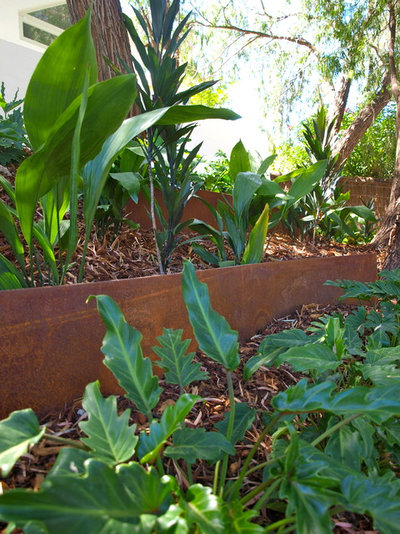
sustainable garden design perth
Top ConsiderationsYour style. Aside from making maintenance easier, edging needs to reflect the style of your home and garden. It should work with your planting themes, color choices, outdoor furniture and garden ambience.
Longevity. It’s wise to base your choice not on price but on the longevity of the product and how well it will hold up in your garden. Mowers and edge trimmers can be unforgiving on products such as bamboo, and some wooden edging doesn’t last long half buried in the soil. Wire may look good but will let the grass wander, and some plastics are not strong and will quickly buckle under pressure. That’s not to say these products don’t work, just that they might not in all situations. Wire can look great in cottage-style gardens with plantings near a path; bamboo in small areas is also effective to create a strong theme. Both make up in visual appeal what they lack in functionality or durability.
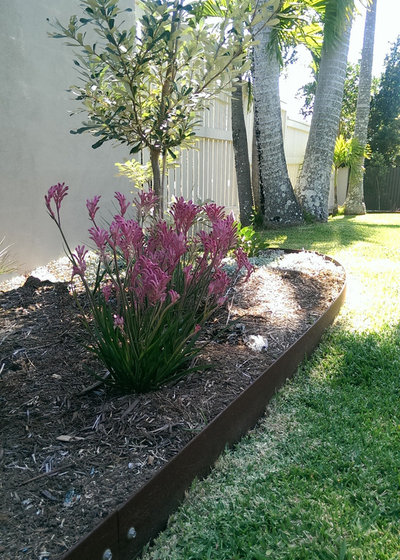
Balance Garden Design
Price. We all know you get what you pay for, and garden edging isn’t any different. If it is cheap, then chances are that it won’t last or it won’t look good for very long. If you can’t afford to have the type of edging you want in your entire garden, then consider mixing it up with a cheaper option. Spend your money on tidying up the key areas, such as the home’s entry or entertainment areas, and always keep in mind making maintenance as easy as you can. A little money spent now will save you in the long run.
Your existing space. When choosing the best material for you, look at the styles that already exist in your home and garden. Decide if you want the edging to be an important visual element of the garden (if not in all areas, then perhaps in some), or if it needs to blend in and be partly hidden by the plants. You don’t need to have the same type of edging in your entire garden, but all the styles do need to complement one another. Finally, consider how durable your edging needs to be. Investing in good edging will make all the difference, in the way that a new frame can bring a painting back to life.
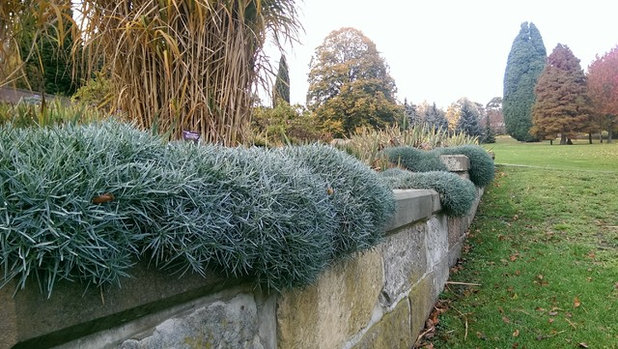
Balance Garden Design
Stone and ConcreteThese materials will stand the test of time and will suit contemporary and traditional gardens, and everything in between.
Pros: Heavier edging materials, such as rocks, concrete blocks and continuous concrete, hold up to nearly all environments and situations and last a long time. The same materials can be used to build retailing walls, which is ideal if you want to be consistent. They come in a wide range of styles and sizes, and even continuous concrete edging can be tinted with oxides to add color.
Cons: They are not always a DIY option, as they need to be laid well to get the most out of them. Plus, due to the wide profile of these materials, they tend to give a bold and visually heavy feel to a garden.
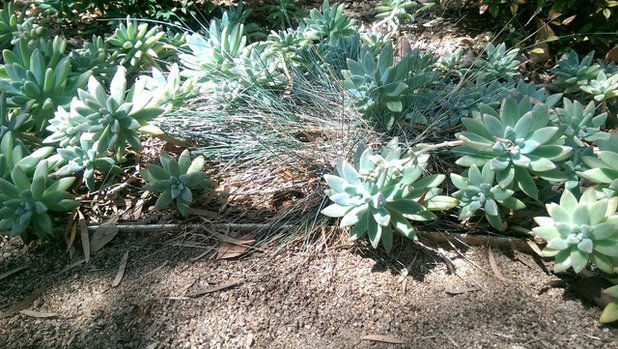
Balance Garden Design
Metal Edging made of steel or aluminum often is used around contemporary homes.
Pros: With its slim, virtually seamless edge, metal edging is perfect for a wide range of garden styles. It is easy to install and long lasting, and works for curves, circles and straight lines. Both aluminum and steel come in several heights, from about 2 inches to about 23 inches (50 millimeters to 580 millimeters), depending on which metal you choose. While aluminum comes in only one color and finish, steel is available as galvanized, stainless or Cor-Ten (which oxidizes and rusts beautifully).
Cons: Metal edging comes in long lengths, up to about 10 feet (3 meters), and installing it over uneven ground can be difficult, as it curves backward and forward but doesn’t flex up and down. Very hard rocky ground poses a few problems, and softer aluminum edging can be damaged by edge trimmers.
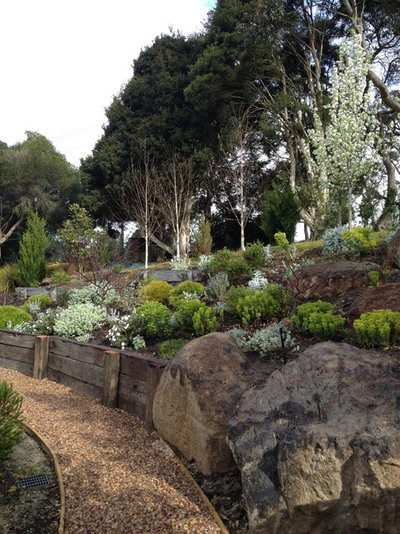
Wells Design Landscapes
WoodThe sustainable choice that blends into natural surroundings.
Pros: Wood can be cheap and easy to install, and it comes in a wide range of styles. Used in combination with other materials, it can help visually merge areas such as decking and pathways. Also, large wooden railroad ties cut into sections and set vertically can create a sense of drama and scale.
Cons: When it comes to longevity, wood can fall short. Even the hardest of woods will eventually be eaten by termites or rot, especially in wetter climate zones.
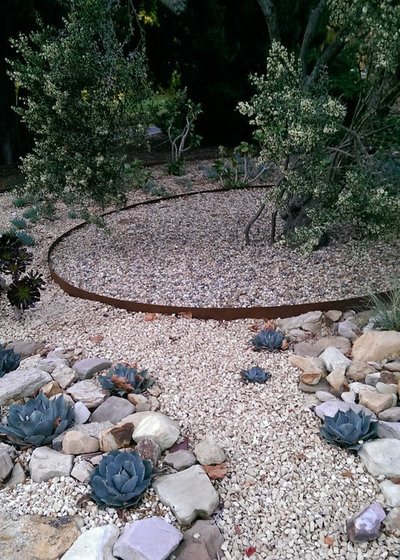
Balance Garden Design
Thinking Outside the SquareBe imaginative with materials. As well as the off-the-shelf materials available, there are many more limited only by your imagination. Old beer or wine bottles, shipping rope, tires cut in half, terra-cotta pipes, dinner plate pieces — all can be used to define the spaces in your garden. Not all of them will look good in every garden, but they all have the ability to reflect personal style.
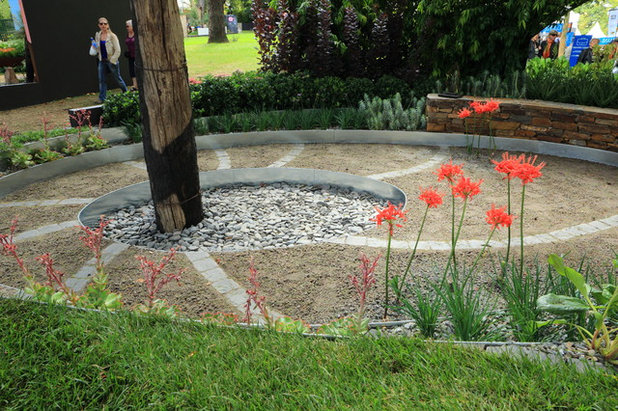
Greenlines Gardenware
Use edging in new ways. Another way to get creative is to use an edging material’s strength or flexibility in new ways. The flexibility of some edging can be used to create intricate curved areas, adding a real sense of fun and mystery to a garden, as seen here. Cor-Ten steel edging looks great once it has weathered and rusted, and the higher profiles can be used as a garden within a garden to make an individual plant or tree a focal point. It can also be used to create steps in lawns or paths and retaining walls.
Tell us: Have you used garden edging? Share your tips and pictures in the Comments section.
More:Small Gem Lawns: More Impact From Less Grass
Garden Edging: Clean Lines for Your Landscape





